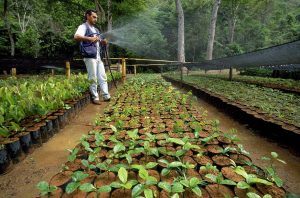Rachel Cernansky in Nature:
 When the Philippines opened its first school of forestry in 1910, the institute’s leaders hatched a plan to restore degraded woodlands surrounding the campus outside Manila. They planted dozens of tree varieties, both native and exotic. In 1913, the school received 1,012 mahogany (Swietenia macrophylla) seeds from a botanical garden in Calcutta, India, and started growing them around the grounds. The American hardwood became such a staple of reforestation efforts in the country that it spread throughout natural areas, so much so that it eventually proved a nuisance. The trees create veritable green deserts: their tannin-rich leaves are unpalatable to local animals and seem to stifle the growth of other plants where they fall. They also produce seeds annually, giving them an advantage over native hardwoods, which do so at intervals of five years or more.
When the Philippines opened its first school of forestry in 1910, the institute’s leaders hatched a plan to restore degraded woodlands surrounding the campus outside Manila. They planted dozens of tree varieties, both native and exotic. In 1913, the school received 1,012 mahogany (Swietenia macrophylla) seeds from a botanical garden in Calcutta, India, and started growing them around the grounds. The American hardwood became such a staple of reforestation efforts in the country that it spread throughout natural areas, so much so that it eventually proved a nuisance. The trees create veritable green deserts: their tannin-rich leaves are unpalatable to local animals and seem to stifle the growth of other plants where they fall. They also produce seeds annually, giving them an advantage over native hardwoods, which do so at intervals of five years or more.
It’s hardly history’s only forestry folly. “The whole notion of what species should be used in restoration tends not to receive, I would say, adequate attention,” says Douglas McGuire, coordinator of the Forest and Landscape Restoration Mechanism at the Food and Agriculture Organization of the United Nations in Rome. Many projects fail because they choose the wrong trees, use too few species or are not managed for the long term. Foresters and ecologists are realizing that for restoration efforts to succeed, they need to think more broadly — about matching trees to their location, about the effects on nearby insects and other animals and about relationships with soil and the changing climate. In other words: the ecosystem. Scientists are now testing and comparing strategies that range from letting nature take its course, to forest-management approaches that look a lot like farming. There is no one-size-fits-all solution, but the work exposes some philosophical friction. Ecologists seeking to increase biodiversity might champion a broad range of species, whereas sustainable-development advocates could back exotic fruit-bearing trees that benefit local people. And researchers seeking to mitigate climate change might push for a single fast-growing variety.
More here.
